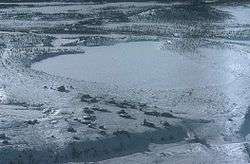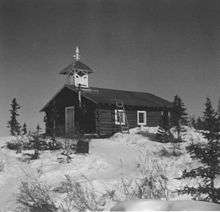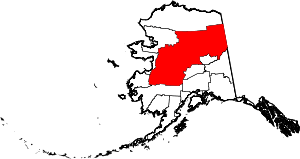Arctic Village, Alaska
Arctic Village (Vashrąįį K'ǫǫ[1] in Gwich'in) is an unincorporated Native American village[2] and a census-designated place (CDP) in Yukon-Koyukuk Census Area, Alaska, United States. As of the 2010 census, the population of the CDP was 152. This was unchanged from 2000. The village is located in the large Gwitch'in speaking region of Alaska, and the local dialect is known as Di'haii Gwitch'in or Kutchin. As of 1999, over 95% of the community speaks and understands the language. (Kraus, 1999)
Arctic Village Vashrąįį K'ǫǫ | |
|---|---|
 Aerial view of Arctic Village in wintertime. | |
Location of Arctic Village, Alaska | |
| Coordinates: 68°7′19″N 145°31′40″W | |
| Country | United States |
| State | Alaska |
| Census Area | Yukon-Koyukuk |
| Government | |
| • State senator | Click Bishop (R) |
| • State rep. | Dave Talerico (R) |
| Area | |
| • Total | 69.8 sq mi (180.9 km2) |
| • Land | 61.7 sq mi (159.8 km2) |
| • Water | 8.1 sq mi (21 km2) |
| Population (2010) | |
| • Total | 152 |
| Time zone | UTC-9 (Alaska (AKST)) |
| • Summer (DST) | UTC-8 (AKDT) |
| ZIP code | 99722 |
| Area code(s) | 907 |
| FIPS code | 02-03990 |
History
Evidence from archaeological investigations indicate that the Arctic Village area may have been settled as early as 4500 BC.[3] Around 500 AD the Athabascan speaking Gwich'in people (often called Neets'aii Gwich'in or "those who dwell to the north")[3] came into the area with seasonal hunting and fishing camps. About 1900, the village became a permanent settlement.[3]
Geography
Arctic Village is located at 68°7′19″N 145°31′40″W (68.121828, -145.527686),[4] on the east fork of the Chandalar River, about a hundred miles north of Fort Yukon.[3] The area consists of flat floodlands near the river, but is mostly wooded hills.[3]
Both the CDP and the "village" have the same total area, 69.9 square miles (181 km2), of which, 61.71 square miles (159.8 km2) is land and 8.12 square miles (21.0 km2) (11.63%) is water.[3][5]
Climate
Arctic Village has a subarctic climate (Köppen Dfc). On September 30, 1970 Arctic Village recorded a low temperature of -13 °F (-25 °C), which is the lowest recorded temperature in Alaska in the month of September. Arctic village heats up very quickly during the months of May and June, peaking in July at an average daily high at 68.9° F (20.5° C), while temperatures start to fall rapidly by the end of July, and even more so during the months of August and September. Summer temperatures are surprisingly mild considering its location North of 68 degrees latitude.[6]
| Climate data for Arctic Village, Alaska | |||||||||||||
|---|---|---|---|---|---|---|---|---|---|---|---|---|---|
| Month | Jan | Feb | Mar | Apr | May | Jun | Jul | Aug | Sep | Oct | Nov | Dec | Year |
| Record high °F (°C) | 38 (3) |
28 (−2) |
43 (6) |
64 (18) |
77 (25) |
89 (32) |
87 (31) |
78 (26) |
72 (22) |
42 (6) |
40 (4) |
49 (9) |
89 (32) |
| Average high °F (°C) | −13.3 (−25.2) |
−6.2 (−21.2) |
13.0 (−10.6) |
29.9 (−1.2) |
49.6 (9.8) |
64.8 (18.2) |
68.9 (20.5) |
59.7 (15.4) |
42.0 (5.6) |
20.9 (−6.2) |
−1.1 (−18.4) |
−2.5 (−19.2) |
27.1 (−2.7) |
| Daily mean °F (°C) | −23.2 (−30.7) |
−18.3 (−27.9) |
−2.1 (−18.9) |
14.1 (−9.9) |
38.3 (3.5) |
54.5 (12.5) |
57.8 (14.3) |
49.1 (9.5) |
32.4 (0.2) |
11.0 (−11.7) |
−10.5 (−23.6) |
−12.5 (−24.7) |
15.9 (−9.0) |
| Average low °F (°C) | −33.1 (−36.2) |
−30.3 (−34.6) |
−17.1 (−27.3) |
−1.8 (−18.8) |
26.9 (−2.8) |
44.1 (6.7) |
46.6 (8.1) |
38.5 (3.6) |
22.8 (−5.1) |
1.0 (−17.2) |
−19.9 (−28.8) |
−22.4 (−30.2) |
4.6 (−15.2) |
| Record low °F (°C) | −68 (−56) |
−66 (−54) |
−62 (−52) |
−43 (−42) |
−21 (−29) |
24 (−4) |
27 (−3) |
17 (−8) |
−13 (−25) |
−35 (−37) |
−56 (−49) |
−57 (−49) |
−68 (−56) |
| Average precipitation inches (mm) | 0.44 (11) |
0.26 (6.6) |
0.41 (10) |
0.23 (5.8) |
0.61 (15) |
1.41 (36) |
1.68 (43) |
1.42 (36) |
1.38 (35) |
0.60 (15) |
0.45 (11) |
0.40 (10) |
9.29 (234.4) |
| Average snowfall inches (cm) | 4.4 (11) |
4.4 (11) |
6.4 (16) |
4.0 (10) |
2.3 (5.8) |
1.5 (3.8) |
0.0 (0.0) |
0.1 (0.25) |
4.7 (12) |
8.0 (20) |
6.7 (17) |
6.8 (17) |
49.3 (123.85) |
| Source: WRCC [7] | |||||||||||||
Demographics
| Historical population | |||
|---|---|---|---|
| Census | Pop. | %± | |
| 1910 | 40 | — | |
| 1930 | 40 | — | |
| 1940 | 24 | −40.0% | |
| 1950 | 53 | 120.8% | |
| 1960 | 110 | 107.5% | |
| 1970 | 85 | −22.7% | |
| 1980 | 111 | 30.6% | |
| 1990 | 96 | −13.5% | |
| 2000 | 152 | 58.3% | |
| 2010 | 152 | 0.0% | |
| U.S. Decennial Census[8] | |||
Arctic Village first appeared on the 1910 U.S. Census as the unincorporated village of "Arctic."[9] It did not appear on the 1920 census.[10] It returned as "Arctic" from 1930[11] through 1960.[12] In 1970, it then returned under its present name of Arctic Village.[13] It was made a census-designated place (CDP) in 1980.[14] Curiously, it reported the same population in 1910 and 1930 (40 residents), and in 2000[15] and 2010 it reported the same population of 152.[16]
As of the census[17] of 2000, there were 152 people, 52 households, and 30 families residing in the CDP. The population density was 2.5 people per square mile (1.0/km2). There were 67 housing units at an average density of 1.1/sq mi (0.4/km2). The racial makeup of the CDP was 7.89% White, 86.18% Native American, and 5.92% from two or more races. 0.66% of the population were Hispanic or Latino of any race.
There were 52 households, out of which 44.2% had children under the age of 18 living with them, 25.0% were married couples living together, 21.2% had a female householder with no husband present, and 40.4% were non-families. 32.7% of all households were made up of individuals, and 3.8% had someone living alone who was 65 years of age or older. The average household size was 2.92 and the average family size was 3.58.
In the CDP, the population was spread out, with 41.4% under the age of 18, 9.9% from 18 to 24, 28.9% from 25 to 44, 17.8% from 45 to 64, and 2.0% who were 65 years of age or older. The median age was 24 years. For every 100 females, there were 114.1 males. For every 100 females age 18 and over, there were 128.2 males.
The median income for a household in the CDP was $20,250, and the median income for a family was $19,000. Males had a median income of $21,875 versus $10,000 for females. The per capita income for the CDP was $10,761. About 30.8% of families and 46.3% of the population were below the poverty line, including 53.1% of those under the age of eighteen and none of those 65 or over.

Education
Yukon Flats School District operates the Arctic Village School.[18]
In popular culture
Literature
- J. C. Hutchins' 7th Son, Book 2, Deceit features Arctic Village as a location containing a clue concerning the antagonist's plans.
- Erin Hunter's book Seekers: The Last Wilderness features Arctic Village as a setting in the book. This is where Ujurak is healed by a native and is also captured by a senator.
References
- "Alaska Native Place Names | Alaska Native Language Archive". www.uaf.edu.
- Arctic Village is recognized by the Bureau of Indian Affairs as an unincorporated Native Village under the Indian Reorganization Act of 1934. See, Indian Affairs Bureau, Department of the Interior (2005) "Alaska Region: A: Native Village of Arctic Village" Federal Register 21 March 2005, Volume 70, Number 53, p. 13519
- Tiller, Veronica E. Velarde (2005) "Venetie" Tiller's Guide to Indian Country BowArrow Publishing Co., Albuquerque, NM, p. 278, ISBN 978-1-885931-04-7
- "US Gazetteer files: 2010, 2000, and 1990". United States Census Bureau. 2011-02-12. Retrieved 2011-04-23.
- "Census 2000 U.S. Gazetteer File: Places", United States Census Bureau
- "ARCTIC VILLAGE, ALASKA - Climate Summary". wrcc.dri.edu. Retrieved 2020-04-19.
- Arctic Village, Alaska - Period of Record : 8/1/1962 to 9/30/1996 Archived 2017-05-08 at the Wayback Machine. Retrieved November 10, 2019.
- "U.S. Decennial Census". Census.gov. Retrieved June 6, 2013.
- https://www2.census.gov/prod2/decennial/documents/41033927n358-359ch10.pdf
- https://www2.census.gov/prod2/decennial/documents/41084484v1ch5.pdf
- https://www2.census.gov/prod2/decennial/documents/00476569ch2.pdf
- https://www2.census.gov/prod2/decennial/documents/37721577v1p3ch2.pdf
- https://www2.census.gov/prod2/decennial/documents/1970a_ak-01.pdf
- https://www2.census.gov/prod2/decennial/documents/1980a_akABCD-01.pdf
- https://www.census.gov/prod/cen2000/phc-1-3.pdf
- https://www.census.gov/prod/cen2010/cph-1-3.pdf
- "U.S. Census website". United States Census Bureau. Retrieved 2008-01-31.
- "Mailing Addresses and Contact Information Archived 2016-12-20 at the Wayback Machine." Yukon Flats School District. Retrieved on December 4, 2016.
External links
![]()
- Arctic Village at the Community Database Online from the Alaska Division of Community and Regional Affairs
- Chandalar River Valley Mountain, north of Arctic Village
